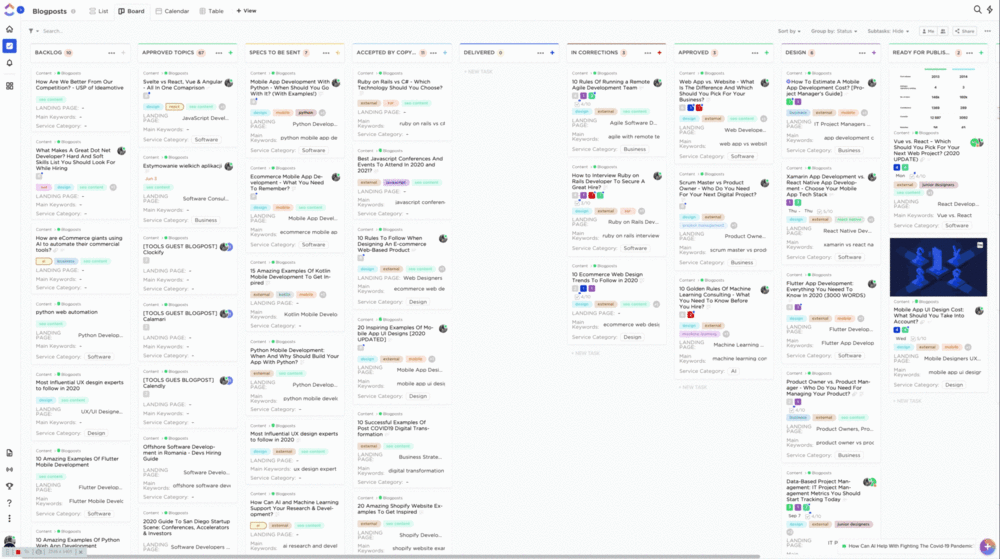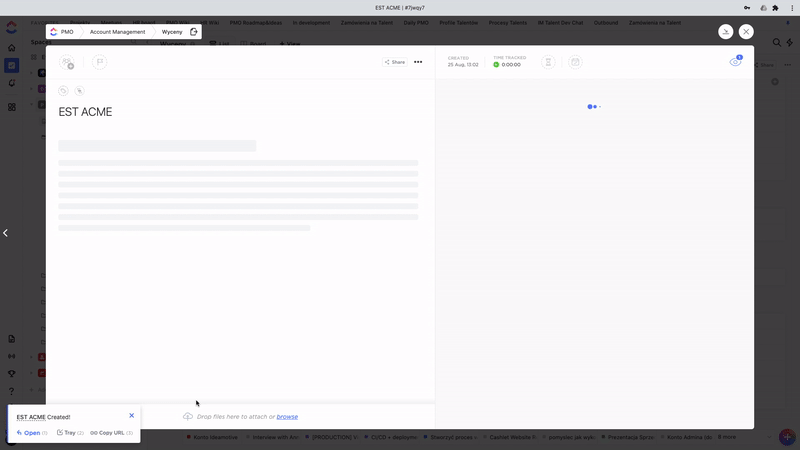Ideamotive & ClickUp: From a Dev Shop to the Tech Talent Marketplace

Sorry, there were no results found for “”
Sorry, there were no results found for “”
Sorry, there were no results found for “”
Oct 14, 2020
9min read

Kamil Osiecki, CEO of Ideamotive, is an executive passionately spreading a digital revolution all around the internet. Guiding Ideamotive to Forbes Diamods Award and Financial Times 1000 fastest growing companies. Connect with him on Linkedin!
This is a story of how we ended a friendship with the industry-standard Jira and introduced ClickUp across teams during the radical business transformation.
We are Ideamotive. A talent-enabled marketplace for software developers, designers, and digital business experts.
In earlier years, as a more classic software development company, we have tested and gained experience in using various project- and task-management tools. The most popular, at least until recently, was Jira.
We too, would implement it into our team (no surprises here…)
Even then we’ve discovered that although it works great for teams with established processes, it doesn’t fit our projects that well. Why? Well, we experiment and test various solutions all the time while optimizing them on the fly. Often we forge the process during the research and development phase and then model and adjust it across different teams.
Moreover, we’ve encountered problems like:
The need of changing the project management platform became even more crucial when we decided to modify our business model.
As the software development market was already changing and the “quest for talent” started getting more and more competitive, we knew we needed to transform into a marketplace-like IT agency.
Now, Ideamotive collaborates with hundreds of tech professionals building on-demand tech teams or providing team extensions for existing product teams. Our ultimate goal is to help our customers hire software developers perfectly matched to their industry, technology, and company culture.
However, such a shift in the business model requires frequent experiments and constant adjustments of processes. To facilitate this change, we decided to find a comprehensive tool that lets our business team conduct smooth and effortless process modeling and testing.
Among our requirements you could find:
Quite a lot.
To be honest, we considered creating our own in-house tool. But then, wild ClickUp appeared, giving us all we could need and more.
We have identified three different types of processes within the company:
Description:
Every company has them. Marketing content production, valuations for clients, and all administration work. The easiest part.
We started with training in automatization and the use of ClickUp. It led to the point where our whole business team consists of the Power Users of ClickUp. As a result, the efficiency of the whole team has grown up together with the pure joy of experimentation.
What we particularly like about ClickUp is how incredibly flexible it is, especially lists with Custom Fields. The interface is vastly user-friendly, and we can easily integrate it with other tools via ClickUp’s API.

Description:
Our software development processes engage not only programmers, but also business and product advisors, UX designers, and AI developers. It starts with idea generation and leads through the release.
Most of the tech teams are hesitant to leave Jira, because of its tech focus. It is integrated with code repositories and is made for Agile processes, such as software development. But we can have it all with ClickUp, and more. With the latest improvements such as repositories integrations, we were able to map the development processes and power them up.
Moreover, we ended up with an issue tracker that suits not only nerds but business people too 😉 It simply makes internal communication much, much easier.
Description:
These are usually the mini-projects associated with changing the business model, growth-focused, scalable tests, or these run by non-technical teams (marketing, sales, HR) to improve performance or optimize resource allocation.
We’ve shortened our prototyping and MVP-building processes. Usually, we employ the Build-Test-Repeat process that enhances the creation of MVPs for our customers.
Using ClickUp, I can easily apply changes to the workflow so that it fits the actual needs of my project. What’s more, the communication within and across remote teams is so much better. Concise, intelligible, and easy-to-follow.
– Jarosław Ziembiński, IT Project Manager, Ideamotive
When you look at the bigger picture, you will soon realize how important it is to facilitate communication and cooperation between technical and non-technical teams. With ClickUp we finally have a communication platform for all of them: developers, testers, sales, HR, or marketing. They can now easily work on the same projects that involve all sides.
We used this new way of collaboration while working on our new site. Almost all our teams were engaged in this project since it was related to our new business model. Furthermore, it’s a great facility for C-level officers to manage all the teams at once.
Yeah, we know Slack is great, and developers love it. But according to our experience in Ideamotive, it doesn’t work for task-related communication.
You know, it has a great business model and can be handy for chit-chat about tonight’s dinner, sharing memes, or having free-form discussions about new games’ releases. However, we need something more to keep clear and comprehensive project communication.
That’s where ClickUp’s comments come in useful. They don’t evaporate with time. Even more, the way they work stimulates more deliberate communication embracing the context of a particular task. Moreover, ClickUp is a distraction-free environment, so it’s much easier to stay focused on your tasks.
Boards in ClickUp are much easier to create and adjust than they’re in JIRA. It’s also easier to replicate your workflow in ClickUp. Moreover, our teams eagerly use ClickUp’s Automations, a feature that has recently been introduced.
The one that is responsible for a great improvement in our efficiency. Finally, if we find a useful feature that’s not included in ClickUp, we can always employ Zapier integration. It gives almost unlimited possibilities.
For example, Google Drive automatically creates documentation and spreadsheet templates, as soon as we start working on a quotation for a project in ClickUp. Moreover, we use Code by Zapier to smoothly get the data we need right from ClickUp.

We work with over 4,000 freelancers around the world. Hence, we need a safe and easy-to-use tool for sharing and change-tracking. You can customize how a particular task is supposed to be shared. ClickUp enables you to choose who can see a task, what exactly they can see, and when they are able to see these tasks.
What we’ve found particularly interesting and useful is the option to invite guests, who can have some insight into our projects. For example, we can use it to show our customers the progress of work.
When you need only standard reports, ClickUp is an absolutely sufficient tool. Apart from pre-configured reports, you can also add some custom fields.
However, if that’s not enough for you, ClickUp offers API access and thorough documentation. We use it to integrate ClickUp with external tools we use for reporting and data analysis (e.g. Google Data Suite).
The introduction of ClickUp in Ideamotive enabled hassle-free and agile transformation into the marketplace-like IT agency. ClickUp utterly increased the smoothness of implementation, testing, and adjustment of our business processes. Moreover, it unleashed the growth potential of our team who has now unlimited realm for experimentation and introduction of creative changes.
– Michał Ślaziński, co-founder & COO of Ideamotive
It was a complex process. Yet, it was rewarding, especially for our COO who was responsible for the research, evaluation, and introduction of the new tool in Ideamotive.
We started with the market research of issue trackers. The leading solutions wouldn‘t fit our needs. Then, our good client suggested we try ClickUp. It was important we had known each other for a long time and shared similar values.
Also, our processes were alike, so we weren’t afraid to give it a try.
We took ClickUp for an extended test ride, so we could experiment some more and check how it works for us. In the beginning, we tested ClickUp within a small team working in the PMO. These people had worked with issues trackers daily and had competencies needed to evaluate new tools and find possible pitfalls.
A couple of weeks later, we knew that ClickUp ideally fits our needs. However, it lacked some solutions we wanted to use in the future. Fortunately, according to the roadmap, most of them were planned for introduction soon. After this stage, the testing team became ClickUp‘s evangelists in Ideamotive.
Positive test results led us to move all of Ideamotive’s operations to ClickUp. Migration from JIRA took us less than two months and was hassle-free. The process was divided into substages. We were migrating department by department. Moreover, each department got its own training.
We also advised the team members on how they can make the most of ClickUp in our company. Today, to support our team and make sure they‘re up-to-date with changes, we regularly conduct training covering all the new features.
The majority of our processes are now replicated in ClickUp. It’s our go-to place for experimentation with new processes and adjustments. Its agility makes it super-easy.
What we find particularly valuable is that ClickUp is easy to implement and ready to use from day one. We‘re absolutely satisfied with the migration to ClickUp. It’s a powerful tool, and we‘re still discovering even more beneficial ways to use it in Ideamotive.
I finally managed to integrate all my tools, processes, and team communication in one power tool. And what’s the most brilliant is it didn’t feel like it was forced – it happened painlessly! As a bonus, setting up workspaces and importing gave me a new level of clarity and oversight over all my projects. Totally worth it!
– Michał Rejman, Marketing Manager at Ideamotive
Now, when our customers ask for a project management tool, we highly recommend ClickUp. We see how it works for us, and how it boosts the growth of our customers. We’ve already created MVPs for our customers using ClickUp, and it works like hell. ClickUp even helped us create a product, which gained the trust and money of investors for our business partner.
Every week, new features appear. We can constantly see how ClickUp is getting better and becoming a more valuable tool for our teams.
Over time, we‘ve noticed an overall improvement in productivity. But even without that, we‘re satisfied because we got lots of positive feedback from specialists across all teams. The implementation of ClickUp made Ideamotive a more Agile organization.
As a result, we deliver value quicker because our processes are much more efficient. This consequently leads to more satisfied customers, since we help them earn more while struggling less.
Don’t just take our word for it: sign up for ClickUp today!
© 2025 ClickUp